[With the release of the public comment draft of the Portland Bicycle Plan for 2030, it’s time to get wonky and learn more about what Portland’s brightest bike thinkers are dreaming up for the future. The story below is the latest in our ongoing coverage of the new plan.]
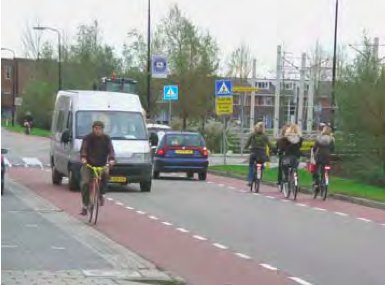
(Photo: PBOT)
Not ones to rest on their heels after installing buffered bike lanes on Stark and Oak and a cycle track on Broadway, the City of Portland Bureau of Transportation (PBOT) is looking to test another innovative (in America) bikeway treatment.
Known as an advisory bike lane, the treatment is common in cities throughout Europe, and PBOT thinks it could be useful in several parts of Portland. The idea has gained the most traction for use on SW Capitol Hill Blvd as part of a neighborhood traffic calming project. PBOT is also looking at the residential streets in East Portland as possible candidates.
Advisory bike lanes are mentioned several times in the Portland Bicycle Plan for 2030 as high-priority or “Tier One” investments.
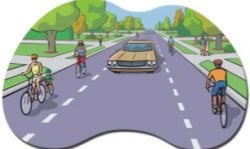
According to PBOT’s Bikeway Design Best Practices manual (created as part of the new Portland Bicycle Plan for 2030), an advisory bike lane consists of dotted white lines that “delineate bicycle areas” on both sides of a narrow roadway (roads where advisory bike lanes would be installed are too narrow for standard bike lanes). With the bicycle areas on each side, the remaining “automobile zone” would be wide enough for only one car at a time. Unlike standard bike lanes — which cars are prohibited from entering — cars could enter the bicycle zone when no one is present.
The idea is that people in cars will drive with more caution due to, as PBOT puts it, “friction created with oncoming vehicles”.
In the Bicycle Plan, PBOT says this type of treatment,
“… may also be useful in areas where there are few opportunities to direct motorists to other streets due to a lack of nearby parallel routes. They may be appropriate where a high density of cycling activity is not immediately expected.”
In their design manual, PBOT notes that one “implementation obstacle” is that advisory bike lanes are not currently in the FHWA’s Manual of Uniform Traffic Control Devices (MUTCD — but neither were the bike boxes or the cycle track). Another obstacle? There’s currently nothing about these in the Oregon Revised Statutes.
Although an advisory bike lane has been specifically mentioned for use in a neighborhood traffic calming project on SW Capitol Hill Blvd., PBOT spokesman Mark Lear says no locations have been confirmed. “We don’t have any specific locations yet identified. We’re in the process of building our capitol budget for next year and hopefully that will drive some of that decision making.”
In the current draft of the Bicycle Plan, PBOT mentions an advisory bike lane project in East Portland (“running north/south roughly along the 12900 block”) as part of their “Base Funding Scenario” which will begin in 2011. The plan also calls for 14 miles of advisory bike lanes in a $100 million list of “Tier One” investments.
Unlike buffered bike lanes or cycle tracks — which were merely re-allocations of roadway space — these advisory lanes would be a big step toward the traffic engineering concept of ‘shared space‘. They would be a significant shift for Portlanders, asking us to negotiate roads not based on what painted lines tell us to do, but on what is considerate to other road users. Will we be up to the task?
— The Portland Bicycle Plan for 2030 is open for public comment until November 8th. Download your copy and find where to direct your comments here.


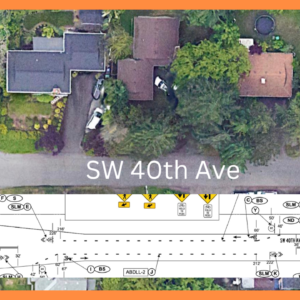
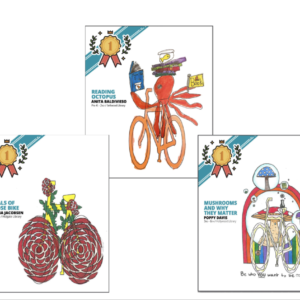
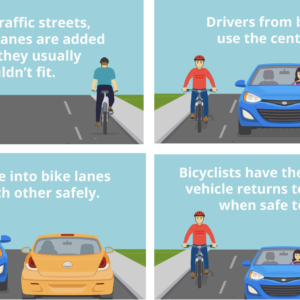

Thanks for reading.
BikePortland has served this community with independent community journalism since 2005. We rely on subscriptions from readers like you to survive. Your financial support is vital in keeping this valuable resource alive and well.
Please subscribe today to strengthen and expand our work.
This type of traffic calming would seem to be of most value in a neighborhood setting. Most motorists, and delivery drivers seem annoyed with cycists on narrow streets, especially during “rush” hours, encouraging manic behaviour. So how calming would this be?
david,
perhaps my story wasn’t clear… but PBOT is indeed only looking at using these in n’hood settings (as opposed to commercial areas).
also, as we push forward for a city that is comfortable for people, not just cars, we’ll have to stop being worried about people getting “annoyed with cyclists”.
How would residential curbside parking work with this scheme?
Dan (hi Dan!),
That issue is listed as a “Disadvantage” of this treatment in PBOT’s Bikeway Design Manual. Here’s the snip:
That leads me to believe that PBOT would look to use these on roads that have no (or very limited) curbside parking.
I can see this working, but it would take some outreach/education to let people know how it’s supposed to work. A lot of PDX neighborhood streets already “calm” traffic this way just because of they’re narrow and have on-street parking. So hopefully people would adapt easily.
The question that these bring up for me is whether drivers will occasionally dart into the bike lane at the last minute (without really looking for cyclists) in order to avoid cars going the other way.
A friend of mine once said to me, when I complained about him driving too close to the bike lane on a two-way road with narrow lanes and bike lanes: realistically, which would he rather hit, another car or a cyclist?
Bike lanes have the same issue, obviously, but at least in the case my friend was in there was enough room to proceed safely at all times if you were careful (he was just commenting on which side he tended to err on). On narrower streets, stopping would be required in some cases, and I question whether people would always do it.
That said, I think these are an interesting idea.
I think this will signifigantly help as a PR tool to help educate all road users that roads without bike lanes are still okay for bikes.
As wierd as it is for us who have ridden on Portland’s roads for years, there is still a sizable chunk of road users that think bikes should ONLY be ridden in bike lanes.
And I apologize if this is in the 2030 master plan or already covered on bikeportland, but what kind of public outreach/education is planned to help spread the word on how to safely use the roads for people who still seem ignorant of how to share the road with a bicycle.
I’m thankful for campaigns like “eye to eye”, but it seems like public outreach for this (as fredlf said above) and other new and existing bike/car road sharing will be just as important, if not more important, as the the physical implimentation of bike “treatments”
Don’t we want to keep cars OUT of bike lanes?
This design has them weaving in and out of bike lanes.
Depending on the number of vehicles using the street, this design could actually impede bicycle traffic. Cyclists would have to slow down or even stop for vehicles that just passed them and then have to use the bike lane to get around a vehicle traveling in the opposite direction.
The only difference between this and what we have now is the cars have to maneuver around each other rather than around bikes.
Either way I prefer cars stay out of the bike lanes.
I think this is brilliant. Almost all two lane two-way road already work like this. Cars have to go over the center line to pass bicycles that are occupying space in the lane.
The center stripe that we currently use makes motorists think about using the road space incorrectly. They focus on staying to the left of the center stripe rather that passing bicyles safely.
On most urban two lane roads a bicyle and a car cannot safely be side by side in the same lane. The advisory bike lane make it clear that the space for passing bicycles comes out of the middle of the road.
I don’t see how parking will make any difference here. Bikes will be in the space to the left of the cars just like they would be to the left of the curb in the picture. Moving cars go around bicylces in the same fashion either way.
There is no functional change here. Cars must already go left of the center of the road to pass bike. The different paint scheme will make driver think differently about the space, though, and more accurately, as well.
Fantastic… do it now.
why not just use sharrows?
btw, does anyone even use those buffered bike lanes on SW Oak and Stark? Every time I’ve been over that way they’ve been completely empty.
This arrangement stops drivers from thinking that they can or should pass bicycles while staying to the left of the center line.
It never occurred to me that the center stripe itself could be the cause to close, dangerous passing. Get rid of the center stripe and some of the impulse to pass too close disappears.
does anyone even use those buffered bike lanes on SW Oak and Stark? Every time I’ve been over that way they’ve been completely empty.
I’ve used them almost every weekday since they opened. And I’ve seen another cyclist in there exactly twice.
The picture from Europe looks like it outlines the potential problem Alexis mentions (6) with this sort of lane.
The cars both dip into the cycle path to avoid each other, even though there are bikes nearby.
I like the idea of restricting curb parking on major bike routes though!
Alexis and AaronF,
what’s the big deal if a bike is nearby.. .as long as the person in the car is going at a safe, reasonable speed?
“what’s the big deal if a bike is nearby.. ”
And how is that different than what happens right now on roads without bike lanes.
The advisory bike lane isn’t really a bike lane the way the law defines them in Oregon. Cars don’t get to use bike lanes here.
The advisory bike lane changes the paradigm for shared space. When there are no bikes, cars drives in the red bit. When there are bikes, the sharing of space is done among the cars.
With our two-way roads, the center stripe suggests sharing is to be done between the bicycle and a car traveling in the same direction.
Sharrows are a similar tool for blended / shared lanes…but they are typically found on wider streets (>22 feet). Streets with advisory bike lanes are among the narrowest bi-directional street type.
As the article mentions…this is becoming a very common bikeway facility type in the Netherlands and in Europe as a whole. The key is that is provides a visual clue for bike access on roadways that were designed and built too narrow for separate lanes.
Typically in the Netherlands it is found on urban low speed (19 mph or less) streets that are about 18 feet wide. The bike lanes are 4 to 5 feet in width with the center bi-directional shared car lane is 10 to 12 feet wide. (I have seen it on streets as narrow as 16 feet though.)
The function of this facility is to promote bicycles having a space (drivers to expect them there) and for drivers to proceed slowly and dip into the cycle lane as needed – they may even have to slow and wait behind a cyclist if there is not room to pass. Additionally I have seen bike riders ride side by side just outside of this lane.
The dashed line allows this for bicyclists as it does for drivers…to dip in to each other’s lane as is needed.
I do not understand why the institutional concern for finding an exact reference to this type of facility, since it already exists in practice (queuing streets) and the dashed bike lane is in the MUTCD. The key is to find streets where it would work with greater safety than the existing conditions.
Both Michael Ronkin and I have been promoting this tool for use for many years. (Happy 60th Birthday today Michael!)
In my low cost proposal for its use on old Evergreen Highway in Vancouver (not yet adopted) – which would have been more similar to the rural use of this type of facility in Europe – I would have added the stenciled curved arrows found in center turn lanes for arterials – that is another similar facility we have that the MUTCD allows this shared lane use by cars.
Jonathan
First of all, I would rather not be hit by a car going at even a reasonable speed! :p
I fail to see how the etiquitte on one of these Advisory Bike Lanes would be any different than on a typical neighborhood road without any stripes or lanes, other than the Advisory Bike Lanes being on roads with no automobile street parking.
Currently in my neighborhood (St Johns):
Cars only typically use the edges of the road when they are passing oncoming cars.
If there are bikes on the road near the edges, cars yield to them until they can safely pass in the middle of the road.
…and we accomplish it without a drop of paint!
AaronF (and others),
For people that are not confident riders (the folks PBOT is trying to attract with this plan), there is a BIG difference between a road with no stripes/paint and one that has 6-foot wide colored bike lanes and a dashed stripe.
the thinking is that advisory bike lanes would make these streets much more comfortable and safe for riders of all skill and confidence levels.
If a painted lane makes you feel more confident on your bike you shouldn’t be riding in traffic.
That paint doesn’t change the interaction between bikes/cars/pedestrians.
In this case it doesn’t designate these as bike only lanes, so having the paint is a false sense of confidence, because these riders are going to dealing with cars in exactly the same way that they aren’t confident in doing so right now.
Being ever vigilant keeps me safer and more confident more than a can of krylon ever will.
The most ambitious thing about this design would be not having parking on either side of the street.
If they allow parking in a configuration like this, I’m concerned it will render the implementation useless. Do they allow parking on these streets in Europe?
I am still not understanding why cyclists roll on the right of motor vehicles. Shouldn’t they roll LEFT of the motor vehicles, closest to the driver, AND out of their blind spots?
none of this will work as as long as a certain percentage of US drivers insist on driving like complete assholes around cyclists.
“Unlike standard bike lanes — which cars are prohibited from entering — cars could enter the bicycle zone when no one is present.”
From Pedal Power 2008:
ORS 811.440 provides about four ways to get into the bike lane:
(2) A person may operate a motor vehicle upon a bicycle lane when:
(a) Making a turn;
(b) Entering or leaving an alley, private road or driveway; or
(c) Required in the course of official duty.
(3) An implement of husbandry [farm machinery] may momentarily cross into a
bicycle lane to permit other vehicles to overtake and pass the implement of
husbandry.
Jonathan (#18) – Be confident or stay off the road! PBOT should be concerned about facilitating traffic flow for all roadway users not engaging in dubious social engineering schemes.
Cycling has certain inherent risks and requires some measure of courage and skill to perform. If someone is so fearful that they need special infrastructure on flat neighborhood streets then they can’t handle high speed roads, steep climbs, technical descents, wet pavement, wind, etc.
In short, people should decide to ride bikes because they want to. Government shouldn’t be spending tens of millions of dollars to encourage them to start riding. If you do spend the money, then put it to use in urban areas where there is more interaction between cars and bikes. Where is there more danger to the commuting cyclist: her neighborhood street or in business zones where cars, trucks, peds, and bikes all converge?
We shouldn’t be encouraging people to start riding? Nonsense.
Let’s start with the health benefits. People who cycle are healthier and will have lower medical costs. And if you don’t care about people’s health, then look at it from an economic standpoint: Healthy employees are productive employees. They cost less to insure.
How about the environmental benefits? Reduced emissions: check.
Reduced dependence on fossil fuels: Check.
How about automobile congestion? Why, if those people are biking, they aren’t yet another car clogging up those roads.
What about personal economy? It sure is a lot less expensive to bike than drive. Cost of gas. Cost of the car, if you go carless. Reduce or get rid of your car insurance all together.
How about some externalized costs: Road wear-and-tear. More people who bike, the less money will need to be spent on road maintenance (which we all pay for out of taxes).
And that’s just some of the reasons we’d want to encourage people to start riding.
Tens of millions of dollars to encourage is chump change compared to what we spend every year to encourage people to drive. And that doesn’t even talk about the other externalized costs of the effect of driving on the environment, health, loss of life, etc.
So yes, we (the Government) should be encouraging people to ride. The biggest barrier to most people for cycling is the perception of safety.
If we can implement infrastructure changes (or other changes — like education training) that will improve the safety and perception of safety to those non-cyclists, we can turn them into cyclists. Then there will be fewer cars on the road AND of the people who are driving, they will have experience at what it is like to be on the other side. They’ll know what it’s like out there on two wheels.
People need to prioritize their goals here. Are you interested in making biking better for YOU or to for making cycling better for everyone?
-Scott E